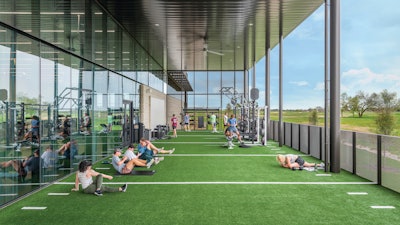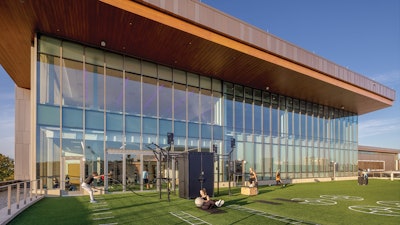
College recreation departments across the country have made student wellbeing a foremost concern, with efforts to provide students holistic support permeating every aspect of the school’s mission. From offering mental health services to the creation of wellness spaces in new and existing facilities, rec directors are looking at myriad ways to help students deal with the stresses of college life in a healthy manner.
As part of that mission, many schools are seeking to encourage students to take their fitness routine outdoors, whether by designing such spaces into new facilities or by making use of existing but underutilized outdoor spaces on campus. Here’s a look at how two schools have successfully provided access to outdoor fitness areas at their new rec centers, as well as a how some institutions are reactivating unused outdoor courts and fields to give students another option for working out — outdoors in the fresh air and sunshine.
University of Wisconsin
Given its location in downtown Madison, the University of Wisconsin’s Nicholas Recreation Center, which opened in 2020, couldn’t accommodate an outdoor fitness area. However, the school had another shot at offering students access to the outdoors at another major project underway across campus in the form of the Bakke Recreation & Wellbeing Center, which opened in April 2023. Architects designed two separate outdoor spaces at Bakke, including the Willow Deck, an outdoor wellness area facing Lake Mendota on the building’s north side, which also accommodates an outdoor turf fitness space on the roof.
Adam Bastjan, architect for Kahler Slater, says there’s a lot to take into account when opening a rec center to the outdoors, as security has to be a priority.
“Really, the rooftop is almost exclusively the right way to go, because it’s inside the control of the facility,” says Bastjan. “The second you do anything down on the main level, you end up having to really fence it off, so that you don’t have anybody hopping over a fence and then getting access into your building without knowing that they’re there. And by the time you do that, you’re providing an outdoor space, but it’s not a great outdoor space — there are no views, you’re cutting down on the natural light with fencing, which is also scalable if someone really wants to get inside the building. So, most of the time people want to build these kinds of spaces on an upper level of some kind.”
That doesn’t mean that placing an outdoor fitness area on the roof of a building is without its challenges. Bastjan explains that one of the primary risks with an open space on a rooftop is that people could be tempted to throw things over the edge, potentially endangering those below.
“It’s not a one-size-fits-all situation by any means, because there are some challenges to opening up a rooftop for usage. At Bakke we had a big enough space up there where we could hold our railings in about 20 feet from the edge,” Bastjan says. “And then most of the railing is actually a big rooftop planter with plants and other things in it, with a railing extension up above it. And that really is preventing people from trying to hop the railing, because it’s more involved than just swinging your leg over a railing and stepping onto a rooftop.”
The space is also under constant supervision. “There’s a ton of cameras up there, and they have staff in that location most of the time,” adds Bastjan. “There’s really good visibility to these spaces, which is important for safety and security.”
But ensuring the space is visible is also important for another reason. “For any rooftop space to be successful, we’ve found that it’s really important to have very active interior space that looks out on it,” Bastjan says. “That way people know that it’s there, they see that it’s there, they see other people using it, and that causes them to want to do the same thing. If you have to go down a corridor and find a little door that goes out to a rooftop deck, the out-of-sight, out-of-mind thing kicks in. Sure, you might get a few people who use it, but a majority of the people won’t even know it’s there.”
The fitness area adjacent to the indoor turf space features a huge operable wall that can open as much as 20 feet wide on pleasant days. This allows free movement between the indoor rack, cardio and strength equipment, and an outdoor rack that holds functional fitness equipment such as medicine balls, battle ropes and pull-up bars. Additionally, there’s a popular slackline outside that is challenging to accommodate indoors due to its space requirements. The outdoor area mainly consists of open turf space for functional exercises and some group classes.
Sadat Kahn, director of facilities and operations at UW’s RecWell, says that both Bakke’s fitness space on the south side of the building, as well as the outdoor wellness space along the lake on the north side, have been a hit with students who are motivated to make every nice day count in a climate that sees months of cold temperatures and snow.
“To get out on some turf, enjoy the sun, it just adds a completely different level of connection for different wellbeing activities,” says Kahn. “We’ve seen students get out there and use that functional equipment anytime we’ve had it open. And then on the other side, on our north side where there’s less sun exposure, we have a teak wood floor deck there. On that one, we could take a mind-body class and do it outdoors. If it’s a really perfect day, we have 20 Adirondack chairs out there, so it kind of feels like you’re at camp and hanging out. Then we see students, instead of doing their studying in the building, they take their laptop or their book outside and they’re studying, they’re reading, they’re hanging out and being social. For us, it really took care of a few different things that we wanted to accomplish in our building.”
 Photo courtesy of Kahler Slater
Photo courtesy of Kahler Slater
Texas A&M
Like Bakke in Madison, Texas A&M University’s recently completed Southside Recreation Center includes a pair of outdoor fitness areas — one a multipurpose area that can accommodate everything from cornhole to yoga classes, and another dedicated turf fitness area on the opposite side of the building.
SmithGroup architect Clint Menefee, who worked on the project, says that it was important for the operator to have specific use cases in mind for each space, which in turn dictated the direction of the design.
“You really have to think about what you want your students to be able to do in those spaces, and then design the space to allow them to do those things,” says Menefee. “We went long and linear for the functional turf fitness area. And then with the other space, which is out by the sand volleyball courts, that’s a little more multipurpose in nature, where they do some outdoor exercise programming, outdoor yoga. It’s really multipurpose.”
Unlike the Bakke spaces, which were designed into upper levels of the facility, Menefee says designers of Texas A&M’s rec center opted to offer the outdoor fitness terrace on the ground level of the facility, which was made possible due to the topography of the site.
“We have a linear outdoor fitness space that is immediately adjacent to the indoor strength conditioning space,” Menefee explains. “It serves as an extension of what’s going on inside, but we utilize the grade to help solve any potential security issues. It sticks up above the grade about 10 feet because it sits flush with the floor line, but it’s really not accessible from the ground plane. It would take a pole vaulter to get up there. So that sort of works in a number of ways — it creates kind of a striking element in the architecture of the building on that south side where it overlooks some wetlands, and it sort of maintains the security line of the building, while still being super accessible to students.”
Menefee echoes Batsjan’s comments about the importance of visibility. “If you want these things to be highly utilized, it really needs to be very obvious that it’s there and that it integrates with the things that are going on inside the building,” he says. “Being immediately adjacent to the strength and conditioning space where students are doing similar activities indoors is ideal. That can’t always be the case, but I think if you can create it as a programming extension to what’s happening indoors, it’s better that way.”
The climate in Texas differs dramatically from that of Wisconsin, and Menefee says efforts were made to ensure the turf area at the Southside Recreation Center didn’t get overheated in the summer months. “In Texas, the climate is hot, so we had to create some shade, and we have some low-velocity fans at the top to create some airflow.”
Texas A&M also purchased some permanent outdoor equipment for the space, and the long turf area is ideal for everything from sprints to functional fitness and group classes. “They have a pretty good mix of equipment, as well as a slam wall,” explains Menefee. “They also bought some outdoor-rated medicine balls and kettlebells, and a gym box kind of thing that stores some of that equipment.”
The projects at Wisconsin and Texas A&M seem to be part of a prevailing trend, as more and more schools prioritize the benefits of connecting with the outdoors.
Menefee says his firm is seeing outdoor fitness space as a priority for an increasing number of campus rec centers, and he says it makes sense for a number of reasons. “Almost every project tries to incorporate something outside,” he says. “Maybe not to the scale of what Texas A&M did. This is one of the bigger ones that we’ve done, but almost every project is always looking for something like this. I think it’s also a way to stretch your budget a little bit if your climate can take it. This kind of thing isn’t free, but there’s also not some of the pricier elements like heating and cooling, those kinds of things. It just has a lower cost of entry for space.”
Bastjan says Bakke was no exception to this trend. “It’s Bakke Recreation and Wellbeing Center. The site is on a very natural part of campus along the lakeshore, and there are a whole lot of studies out there that show how beneficial it is to be fully connected with the exterior, and one of the best ways you can do this is to physically go outside. But it’s great to be outside and still have the equipment, to still have fitness tools that you’re used to using. I mean, you can go run outside, you can go do functional fitness on a trail right on the lake. But to be able to have the equipment to actually back up what you want to do, that’s really what students want.”





































